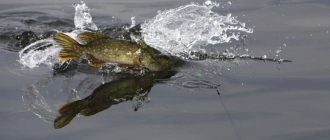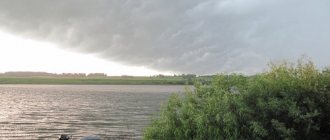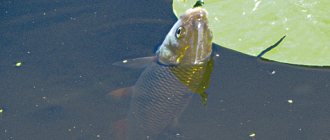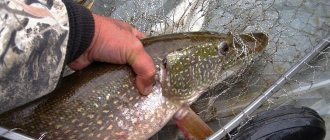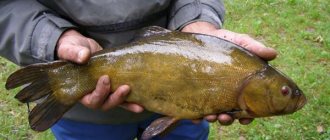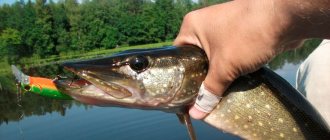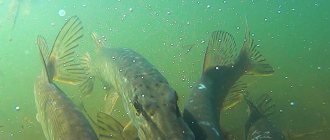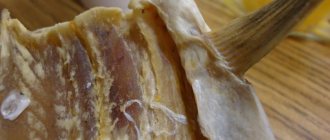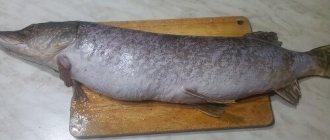They say that to catch pike, you need to know three things: where to fish, when to fish and what to fish for.
However, it happens that the right body of water seems to be chosen, the right time and place, a proven bait hangs at the end of the cord, but the pike refuses to bite.
Don’t be upset, you are on the right track, all you have to do is push the capricious “beauty” a little, and the bite will be “like the Black Rock.” Use one or more tips to activate the bite of a passive pike.
Look for pike in places other than usual
Have you always caught pike here in snags, but today it’s quiet and empty? Try looking in an open place or near those reeds over there. Despite everyone's opinion, pike does not stand still. She goes after white fish. And white fish are an unpredictable object.
Doesn't bite in snags today - look for pike in the open
Time of year when pike don't bite
Let's determine the time of year when pike bite:
- This is definitely the time immediately after the ice drift, when the reservoir was freed from ice.
- This is the time before the start of spawning, the so-called pre-spawning zhor.
- This time is 2 – 4 weeks after spawning.
- This is the time from the end of summer until the beginning of freeze-up.
- This is the first ice.
These are the main periods of the year when pike bite with passion and eat virtually any artificial bait. If you get to the pond at this time, then there should be bites. If they are not there, then go to the next point; the time of year has nothing to do with it.
When does pike not bite on artificial baits, during what periods?
- Firstly, this is the wilderness, when you can only seduce a predator with live bait, and then only once in a while.
- Secondly, this is the spawning period and the post-spawning period (2-3 weeks), when the predator is sick and catching it with artificial bait is very problematic.
If you come to a body of water at exactly this time, then all your tricks when catching a predator with artificial bait may not be realized in the form of pike bites.
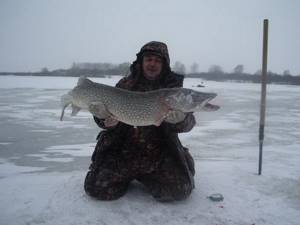
In the dead of winter, when pike do not bite on spoons and balancers, you can only catch it with live bait.
Change baits
This is one of the most important rules in the absence of a bite. Change baits as often as possible. You should try as many variations as possible. As soon as you have picked the one that is biting, stop changing baits.
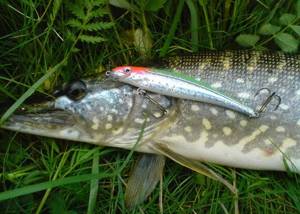
Sometimes a radical change of bait brings quick results
Tackle
Due to incorrectly selected gear, you can return home without a catch. To catch pike, it is recommended to use a fishing rod about a meter long. In winter conditions, the fishing rod for trolling should be equipped with a nod, since at this time the bites of the toothy predator, especially on artificial baits, are very careful and careful.
You simply can’t feel the pull of the pike. The predator will not hold the metal bait for more than three seconds, and if you do not hook it in these seconds, it will spit out the bait.
In clear and clean water, you should use monofilament fluorocarbon fishing line to catch pike, as it is inconspicuous and does not scare the fish so much. It is better not to use wicker in winter. It is easily damaged by the sharp edges of the holes.
It is mandatory to use metal leashes in the equipment. Well, every fisherman probably knows about the reliability of hooks for catching pike (including those attached to winter artificial baits).
Take risks with baits
The last and most important rule. If you are protecting your bait from snagging and you are not getting a bite, you need to change this situation. Stop saving your bait. Throw unhooked ones into the very center of the grass islands. Set up Texas and Carolina rigs and fish snags. Are you afraid to throw your favorite Japanese wobbler for 1,500 rubles into a “deadly” place? Place single hooks made of thin wire on it and feel free to throw. A grateful pike will be floundering in your landing net in 5 minutes.
How not to catch pike
- home
- Archive
- Nizhny Novgorod fisherman
- How not to catch pike
Sergey Klyuev
So much has been written on the topic of life and pike fishing that sometimes it seems that everything has been written. The approach to writing a full-scale article about pike fishing by one author or another is almost the same. First, descriptions are given of the places where pike live. This is followed by some details of pike biology and a number of recommendations for catching this fish. Cases from the author’s rich practice are more or less successfully woven into the outline of the article, illustrating this or that idea.
Not on the instructions of the editors, but at the behest of my soul, I also wanted to write about pike. But not in the usual way, but turned upside down. There will probably be little practical benefit from reading this kind of opus, I warn you in advance, but it will allow the reader to look at the problem of pike fishing from a slightly different point of view. Go?
Where pike are not found
Pike is an unusually tenacious creature. Place asp, pike perch, bersh, perch, pike on the kukan, and you can be sure that the pike will be the last to die. More than once, my friends and I caught pikes “with an earring” - with a tee or even a whole spoon in the mouth. In a reservoir where, apart from frogs, there are no other living creatures, pike successfully eat frogs. In a reservoir where there are not even frogs, it eats its own young and generally feeds on what God sent.
Remember how in the seventies and eighties of the last century we were all afraid of the expansion of rotan? Scientists assumed that rotan would soon destroy all native fish and become the only fish in our rivers and lakes. However, in practice everything turned out differently. In those reservoirs where pike were present, rotan behaved more than modestly - according to the principle: I don’t care about fat, I wish I could live! In short, in swamps, ponds, peat bogs, oxbow lakes, lakes and ponds, pike live and thrive.
And pike live in fast currents - that’s also true. It is found (and caught) in places on the Oka and Volga where it is not easy for a super-rheophilic chub to hold on. Have you seen such a pike? She is elongated like a sausage, and with a weight of four kilograms, her length is only a little less than a meter - oh, how!
This concerns our big rivers. What about small ones? Also from pike, hello hot. In the reservoir, the status of which fluctuates between a river and a stream, there are pike of a very decent size. A very edible size, if you will. And if in a large river, in addition to fishermen and poachers, the pike is disturbed by catfish and large pike perch, then in a small river the pike feels like a sovereign mistress and tastes everything that one way or another falls within its domain.
So where are pike not found? Perhaps it is found everywhere in the summer. Here we can give up, recognizing the sad fact of the ubiquity of pike in our rivers, lakes and swamps. But now winter comes - and the pike’s range is significantly narrowed. On the current, for example, it becomes more and more difficult to meet it. And this is not a matter of natural laziness. The usual food for river pike - roach, perch and small silver bream - scattered across the bays for the winter, so the pike went there too. Interesting fact: in places where winter pike fishing is successful in summer, you can go five days without seeing a bite. And, conversely, in those places with a current where pike are caught consistently in the summer, in the winter there is a complete “bare” - not a bite. Well, like people or something like that: it’s more interesting in the country in the summer, and in the city in the winter.
In winter quarters, pike loves driftwood. If there is plenty to choose from, the pike will always prefer snags to a “clean” place. However, the opposite sometimes happens. This is when a pike follows a school of peaceful fish through the first ice, for example. There was no pike in the bay, suddenly - bang! - full of pike. This means that a bream or a silver bream came into the bay to feed... or a roach - it doesn’t matter. But it is important that from mid-autumn until the first ice, pike ceases to be such a sedentary fish and may well make a kilometer-long (or even more!) forced march.
And with the bottom substrate, pike have their own preferences. Hard soil is still preferable to silty soil. There are fewer leeches on the shell rock or more forage fish - again, that doesn’t matter. The bottom line is that pike are more likely to be caught on hard ground than on soft ground. Sometimes even a patch of shell rock is enough. Here's an illustration.
In the pre-winter months I ride on a motorboat along the snarled Volga bays around Kamenka. Once I lifted the anchor, there was sapropel and silt on the “paws”. The second time after an unsuccessful fan of casts I raise the anchor - still the same silt. On the third set, two pike were caught in the immediate vicinity of the boat. Well, one is only a kilo, and the second is about three, a completely standard specimen. My mood, of course, improved, and I also gave up the “beard.” I raise the anchor - clean as glass! Only then did I notice that the “step” in front of the boat was becoming distinct, even ringing. Therefore, the pike, ignoring the places clogged with silt, gathered on the shell rock. The search became more methodical.
In winter - the same garbage. The shell gives a head start to the silt. If there is still an almost completely indistinct flow (it barely lasts, as they say) - quite good.
When you can't catch pike
Well, with the time of year everything becomes more or less clear. Pike can be caught well almost all year round, rather than being caught three times a year.
The first case is spawning. If you forget for an hour that you can’t fish during spawning, and go to the bay where the pike spawns, and start throwing spinning baits into the bushes where it spawns, then most likely you won’t catch anything. The pike has no time to eat; it has a much more vital issue on its agenda - it needs to get rid of the eggs.
It can be formulated in such a way that it is necessary to give life to the offspring, but the pike, believe me, cares little about its offspring. This is not a swan... and not a beaver... In general, there is no need to catch pike during spawning. Neurosis doesn’t stop her from earning money, nor does it interfere with herself.
The second case is deafness. When the water in a shallow area warms up above 20 degrees and is overgrown with all sorts of algae, the pike refuses to eat. Whatever you throw at it, “don’t care.” Is it possible to catch pike at this time? Otherwise! There will always be one or two fools. But catching pike in the wilderness is almost impossible.
The third situation is wilderness. The first ice is behind us, under the ice the algae are rotting, there is not enough oxygen for everyone, life processes are slowed down to a state of almost complete indifference to food. It is traditionally believed that the wilderness “attacks” us in January. It is not true. It is enough to take a fishing diary and look through it for about fifteen minutes, it will immediately become clear that the deep winter is not January at all, but the end of February - mid-March. In any case, this is 100% true in relation to the upper reaches of the Cheboksary reservoir.
We figured it out with the time of year and started pike fishing in April, July and February. Further.
Times of Day. The main thing is morning. No one has canceled the morning yet. For Kamenka, for example, in nine out of ten cases in winter such an algorithm works. If the activity of the fish in the morning is weak (and not only pike, but everyone in general), then the bite will be bad all day. Morning is the main time of day for a fisherman. The opinion that in late autumn, for example, in the early morning no one bites and you have to wait for the “exit” at 9-10 in the morning, is an excuse for lazy people and couch potatoes. There were cases in November when a good pike bite from the early morning provided 80% of the catch, and the rest of the day accounted for only 20%.
Fishing for pike in the early morning is especially important if there is a sunny day ahead. Here, whoever didn’t have time is late, two hours after sunrise you can safely switch to catching pike perch, bersh, perch, and you can simply forget about pike until the evening: there will be no bite. No, there are, of course, exceptions, that’s what fishing is for, to constantly upset and delight us, but in the overwhelming majority of cases the sun is the enemy of pike fishing.
And here's what's interesting. Well, in the summer it’s clear why pike don’t like the sun: the objects of pike hunting perfectly see all the maneuvers of the predator and with much greater difficulty get onto the pike table. But why in winter, on a bright sunny February day, under a thick layer of ice and snow, pike does not go hunting remains a mystery to me. However, familiar garrison fishermen unanimously assert: on a sunny day, the entire bite occurs during the dawn and sunset hours, and mid-day outings are extremely rare and random.
In other weather - cloudy, rain, snow, wind, waves, thunderstorms - pike can be caught. And at times, the worse it is for a fisherman in a boat or on ice, the more active the pike is.
What you can't catch pike with
As we are already about omnivore. It eats from insects to ducklings, from fry to their own kind, from frogs to muskrats. “Moving means it’s edible” is the pike’s motto. And in a full set of spinning gadgets, there is hardly a bait that, under certain conditions, would not be able to catch a pike. Pike perch, perch, and asp are much more selective in this regard - honor and praise to them.
However, here too there are certain patterns that allow you to both catch pike and not catch it.
The first is the size of the bait. For summer fishing, for spinning, for example, this matter is less relevant. You can successfully catch pike with a two-inch and a four-inch twister at the same time of year, on the same day. But in winter, a single pike is rarely tempted by a small perch lure. No, of course, there are cuts, and even catching of kilos and more pikes with spoons 5, 4 and even 3 centimeters long. But in general, pike are of little interest to perch lures. Exactly the same as the perch balancer.
In short, you need to increase the size of the bait so as not to be a fool and catch a winter pike. Whoever didn’t increase it didn’t catch it.
However, here (as in everything, perhaps) one must know when to stop. Well, in a particularly good mood, a pike will bite even a half-kilos of white bream with three pounds of it. And he will think for a long time about what to do with him when he strangles him. However, most often the predator is in a lower than average mood, otherwise there would be no pike left for us. And in a “C” mood, a pike will covet a small perch much faster than a two-hundred-gram perch (which in itself is a completely edible fish, according to my coordinate system).
It must also be said that in different bodies of water pike is not caught with different baits and different live baits. Live baits are probably easier to deal with, so let's start with them.
These peat pits are shallow. Pike, perch and rotan live in them. In some quarries, pike bite better on perch, in others, on rotan. What is the secret is probably impossible to understand, the reservoirs seem to be very similar. If you deepen the experiment and bring crucian carp to the peat bogs, then it’s a total mess: on one peat bog the pikes will tear it off with their hands, and on the other they will completely ignore it. A mystery of nature, to be sure!
However, from the entire variety of forage fish that claim to be live bait, only a few fish should be excluded as species. These are burbot, tench and pike perch. The latter will immediately fall asleep on the hook, and it’s a pity to transfer undersized pike perch to live bait. And pike seem to have no respect for burbot and tench at all, just like food. Again there may be exceptions! But if you have a choice, it’s better not to engage in nonsense, but to put perch and roach on the doubles - it will be more reliable.
More reliable, but not better. Since the flooding of Cheboksary, Bor fishermen have gotten into the habit of going to Kamenka. We fished well with spinning rods and reels, but it was better (or rather, more) in winter with girders. At first we caught perch with stationary girders, but life forced us to switch to sports girders (those with flags and requiring running).
And then they started experimenting with live bait. It turned out that pike bite best “on fry,” as the Bor gherli call the sprat. Together with pike, which, as it turned out, loves fatty sprat somewhat more than lean perch, decent perch began to be caught in this business. Yes, there were more idle bites because of this perch, but it’s better, you see, to run idle to the girder one more time than to pointlessly look at silent tackle all day.
Under certain conditions, pike also refuses certain artificial baits. For example, we usually fish with poppers in the hot summer months, and in early summer and autumn we fish with something else. Until recently, I thought that pike generally don’t take poppers in cold weather. However, this season my perspective on this issue has changed significantly.
Late April, midday, the sun reluctantly peeks out from behind the covering clouds. We drive across the bridge in Kamenka. A friend sees the slaps of some fish. Despite my persuasion, he stops, gets out of the car, climbs into the trunk and collects the spinning rod. From the bait he chooses... that's right, popper. I’m trying to prove that pike don’t take a popper in April, but a friend goes to the river and catches a half-kilos bee-eater on the third cast. I am destroyed, my comrade rejoices.
Six months have passed. At the beginning of November, a friend of this friend approaches the same place with a spinning rod and... catches an eight-hundred-gram pike with a popper. Fantastic? Otherwise! I could tell you something different, but the scope of a magazine article would not fit even a tenth of my “pike stories.”
I'm wrapping up. I hope the meaning is clear. Pike is a cunning “beast”. Trying to survive as a species, and therefore learning the science of fishing much faster than most anglers. And more and more often it is not possible to catch it even in “good” places than to catch it. This means that you need to look for “bad” places, fish where there have never been pike (just as there were no fishermen), fish when no one is fishing and where pike have never pecked before.
In general, you need to surprise the pike. And be amazed at the results of the fishing.
Nizhny Novgorod fisherman No. 1(6), 2008
Who to offer to pike
An unafraid predator can take any bait, but there are very few of them left. In most reservoirs, the harsh pressure of amateur fishermen, combined with the efforts of poachers, leads to the fact that the remaining fish become very cautious, suspicious, and wary of the bait offered to them. The main dish in the diet of pike is fish: roach, perch, crucian carp; predators do not disdain smaller representatives of their own species. For this reason, these types of fish can be used as bait. You can also hook a small gudgeon, bleak, loach, ruffe, rudd, silver bream - these fish are found in abundance in our reservoirs.
What is the best live bait for pike in winter?
Many anglers believe that the best live bait for pike in winter are perch and roach. This is explained by the fact that pike attack these fish especially aggressively, and on a large river they are often the only live bait suitable for catching a predator.
Sometimes, when attacking a perch and clinging to a hook, a pike may think that these are its spines, and this is also convenient for the fisherman. In addition, the dense scales of the perch force the pike to hold it in its teeth longer without feeling the catch. These live baits are also distinguished by their special survivability at home, so they can be caught several days before pike hunting. In winter, perch can often be found closer to the shore, and roach in shallow water where there is a lot of vegetation.
Ideally, the best live bait for pike in winter is the one with which it is caught in a given body of water at the right time. Which one and what is better can only be determined experimentally.
Subtleties of fishing
Fishing with live bait is possible at any time of the year, but there are some subtleties and secrets of success in this matter. Experienced fishermen know them, but beginners will have to learn them on their own if they don’t have an older comrade. To always be with a trophy when fishing using this method, you must:
- first study and understand the rules for planting live bait;
- be able to form gear for any of the selected fishing methods;
- take into account seasonality and select a basis based on this;
- use live bait that was caught in the same reservoir; it will be “more familiar” to the predator;
- choose the right promising location, to do this, carefully study all the material on this topic;
- use a leash, without it the predator will easily be able to bite through the base of the tackle;
- use high-quality tees, and select them depending on the size of the fish;
- choose a sinker slightly less than the weight of the bait; it should not drown the bait, but also not give it much will;
- Immediately after the mug or girder is triggered, there is no need to grab the tackle and spot it, let the pike turn the bait in its mouth and grab it as far as possible;
- You should fish it out gradually; be sure to have a grab bag with a fairly long handle or a hook nearby in winter.
The rest of the skills will come to the fisherman over time; everyone, if desired, will learn to feel the tackle and skillfully control it.
Pike can be caught with live bait all year round, and it is very successful. For successful fishing, you just need to decide on the gear to use and install it in a promising place in the chosen reservoir.
You can ask your question to our author:
When fishing in the current, live bait is attached in several ways:
• by the upper lip - the best option for pike, for the simple reason that without suspecting anything, it immediately swallows the bait, and the number of escapes decreases significantly; • thread a leash under the gills and remove it through the mouth - this method is also effective; • there is another interesting method, with minimal damage to the live bait - its tail is tied with a thread, to which the hook clings.
In still water, live bait is attached to the back - the tee hook pierces the fish under the dorsal fin. In addition to liveliness and mobility, there is one more condition: the size of the bait must be appropriate. That is, if you want to catch a heavy pike, the bait should be of sufficient size for such a trophy. A large pike requires a large live bait, but its size in any case should not exceed 15 cm.
Choice of live bait
For successful fishing, you need to be able to choose the right bait, in our case live bait. There are no difficulties here; it is only important to know the preferences of the predator in the water area where the capture is planned.
The predator’s diet includes almost all representatives of the ichthyofauna; pike does not disdain:
- crucian carp;
- roach;
- brush;
- bleak;
- perched water;
- line;
- perch;
- silver bream;
- bream.
In the summer, it is a pleasure to feast on frogs, but this is the topic of another article on our website.
The most commonly used are crucian carp; they are easy to find at any time of the year, and their vitality is at a decent level. Roach is also an excellent bait, but is used a little less often.
It’s worth choosing bait for live bait gear based on the following indicators:
- size from 5 cm;
- the most active ones are selected from the freshly caught ones;
- It is advisable to sort out injured individuals.
It is worth understanding that for trophy pike the live bait should not be small. In the autumn, they place a larger fish, then a trophy pike will bite on it.
Catching pike with dead bait in winter
Experienced fishermen note that in many reservoirs, large pike often prefer dead bait, which lies motionless on the bottom, and do not chase live bait. If the water in the lake is cloudy, then the fish rely mainly on their sense of smell rather than their sight. Hunting for pike using dead bait has become the most preferred method for many anglers recently.
If you catch pike with large live bait, you should attach hooks to different parts of it, since otherwise the pike may eat the bait without reaching the hook.
It should be noted that whole small fish can be used as dead bait, but it is better to divide large fish in half. This method will allow you to quickly attract a predator due to the distribution of internal substances of the dead bait. In this case, it is better to cut the fish diagonally before putting it on the hook.
If a pike has caught a dead bait more than once, it may become suspicious and not swim up to the stationary fish. To do this, some fishermen use a trick by inflating the fish’s head with a syringe in advance or inserting a piece of foam into it. This will keep the head of the bait higher than the body and attract the attention of the predator.
For frozen capelin
Often, instead of live bait, frozen capelin is used for pike. This bait can be prepared in advance and for future use. One of the disadvantages of such bait is its immobility, to which pike rarely react. The movement of frozen live bait can only be achieved by the flow of the river, which is not always the case. However, the smell and unusual taste of capelin still attracts many predators, so many fishermen use this bait in the absence of live fish.
What size should a live bait be for pike?
The size of pike that a fisherman intends to catch depends on the type of bait used. Accordingly, the larger the bait, the larger the fish you can catch. But don't overdo it. The best size for pike is considered to be a live bait size of 8-10 cm, but you can use smaller ones.
For large pike
Such fish, as a rule, are found in deeper reservoirs and are best caught with large live bait. The bait for large pike should be at least 10 cm in length. You can use larger fish, for example 20-25 cm. For large trophy-sized predators, you need really large live bait, for example crucian carp or roach weighing at least 200 grams. It should also be noted that it is better to catch a large predator using live bait than artificial bait.
About
